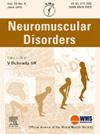Late-onset multiple-acyl-CoA-dehydrogenase deficiency-like condition: a case series from the West of Scotland
IF 2.7
4区 医学
Q2 CLINICAL NEUROLOGY
引用次数: 0
Abstract
Multiple-acyl-CoA-dehydrogenase deficiency (MADD) is a rare metabolic disorder affecting fatty acid and amino acid metabolism. Local experience and evolving literature highlights a paucity of genetically confirmed cases. A retrospective analysis of patients attending the West of Scotland neuromuscular service with a working diagnosis of late-onset MADD was undertaken. Nineteen cases were identified with median onset age of 52 years and female predominance. 8/19 presented with rhabdomyolysis and 11/19 with a subacute myopathy over mean 12.6 months. 14/19 had evidence of a provoking factor prior to clinical presentation and 16/19 had current sertraline use. All cases had abnormal acylcarnitine profiles in keeping with a MADDlike profile and abnormal skeletal muscle biopsies. Abnormal lipid accumulation was seen in 14/19, ranging from mild increase in lipid droplet size to gross lipid excess in seven cases. 4/19 were heterozygous for likely pathogenic ETFDH gene variants; no second variants were identified within the limits of testing available. All showed variable improvement following riboflavin therapy, advice on nutrition and advice on sertraline discontinuation. We suggest a late-onset MADD-like myopathy is much more common in the cohort than primary genetic MADD. Non-genetic and acquired factors may be causative, in keeping with the evolving literature.
晚发型多酰基辅酶a脱氢酶缺乏症样病症:来自苏格兰西部的病例系列
多酰基辅酶a脱氢酶缺乏症(MADD)是一种影响脂肪酸和氨基酸代谢的罕见代谢性疾病。当地经验和不断发展的文献强调了基因确诊病例的缺乏。对参加苏格兰西部神经肌肉服务的患者进行回顾性分析,诊断为晚发性MADD。19例患者中位发病年龄为52岁,以女性为主。8/19表现为横纹肌溶解,11/19表现为亚急性肌病,平均时间为12.6个月。14/19在临床表现前有诱发因素的证据,16/19目前正在使用舍曲林。所有病例都有异常的酰基肉碱谱,与疯狂样谱和异常的骨骼肌活检相一致。14/19例出现异常脂质堆积,7例脂滴大小轻度增加至脂质过量。4/19为杂合子,可能为致病性ETFDH基因变异;在现有的检测范围内未发现第二种变异。在核黄素治疗、营养建议和停用舍曲林建议后,所有患者均有不同程度的改善。我们认为迟发性MADD样肌病在队列中比原发遗传性MADD更为常见。根据不断发展的文献,非遗传因素和后天因素可能是致病因素。
本文章由计算机程序翻译,如有差异,请以英文原文为准。
求助全文
约1分钟内获得全文
求助全文
来源期刊

Neuromuscular Disorders
医学-临床神经学
CiteScore
4.60
自引率
3.60%
发文量
543
审稿时长
53 days
期刊介绍:
This international, multidisciplinary journal covers all aspects of neuromuscular disorders in childhood and adult life (including the muscular dystrophies, spinal muscular atrophies, hereditary neuropathies, congenital myopathies, myasthenias, myotonic syndromes, metabolic myopathies and inflammatory myopathies).
The Editors welcome original articles from all areas of the field:
• Clinical aspects, such as new clinical entities, case studies of interest, treatment, management and rehabilitation (including biomechanics, orthotic design and surgery).
• Basic scientific studies of relevance to the clinical syndromes, including advances in the fields of molecular biology and genetics.
• Studies of animal models relevant to the human diseases.
The journal is aimed at a wide range of clinicians, pathologists, associated paramedical professionals and clinical and basic scientists with an interest in the study of neuromuscular disorders.
 求助内容:
求助内容: 应助结果提醒方式:
应助结果提醒方式:


